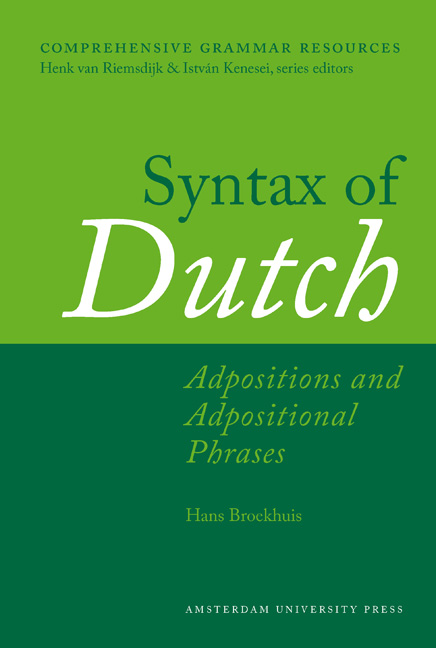Book contents
- Frontmatter
- Contents
- Abbreviations and symbols
- Preface and Acknowledgments
- Introduction
- Chapter 1 Adpositions: Characteristics and Classification
- Chapter 2 Projection of Adpositional Phrases: Complementation
- Chapter 3 Projection of Adpositional Phrases: Modification
- Chapter 4 Syntactic uses of the Adpositional Phrase
- Chapter 5 R-pronominalization and R-words
- Glossary
- Subject Index
- References
- Miscellaneous Endmatter
- Miscellaneous Endmatter
Chapter 4 - Syntactic uses of the Adpositional Phrase
Published online by Cambridge University Press: 10 December 2020
- Frontmatter
- Contents
- Abbreviations and symbols
- Preface and Acknowledgments
- Introduction
- Chapter 1 Adpositions: Characteristics and Classification
- Chapter 2 Projection of Adpositional Phrases: Complementation
- Chapter 3 Projection of Adpositional Phrases: Modification
- Chapter 4 Syntactic uses of the Adpositional Phrase
- Chapter 5 R-pronominalization and R-words
- Glossary
- Subject Index
- References
- Miscellaneous Endmatter
- Miscellaneous Endmatter
Summary
Introduction
This section is concerned with the syntactic uses of adpositional phrases shown in Table 1. For all these syntactic uses we will investigate at least the following four syntactic properties: the possibility of °topicalization, °scrambling, °PP-over-V, and °R-extraction.
Adpositional phrases used as arguments
The use of adpositional phrases in positions that are normally occupied by a nominative or an accusative noun phrase is restricted to constructions in which the adpositional phrase acts as the °logical SUBJECT of a complementive: the two examples in (1) illustrate, respectively, a copular and a vinden-construction, in which the locational prepositional phrase onder het bed ‘under the bed’ functions as the SUBJECT of the nominal predicate een leuke plek ‘a nice spot’.
(1) a. Waarschijnlijk is onder het bed een leuke plek.
probably is under the bed a nice spot
b. Ik vind onder het bed een leuke plek.
I consider under the bed a nice spot
Example (2) provides similar examples in which the directional postpositional
phrase de berg op functions as the SUBJECT of the adjectival predicate gemakkelijker
‘easier’.
(2) a. De berg op is gemakkelijker dan de berg af.
the mountain up is easier than the mountain down
‘It is easier to ascend the mountain than to descend it.’
b. Ik vind de berg op gemakkelijker dan de berg af.
I consider the mountain up easier than the mountain down
‘I consider ascending the mountain easier than descending it.’
It has been argued that in examples like Het is warm in de kamer ‘It is warm in the room’, the PP in de kamer ‘in the room’ also functions as a SUBJECT of the adjectival predicate warm ‘warm’, albeit that the pronoun het ‘it’ is used as an anticipatory pronoun introducing the SUBJECT-PP. Constructions like these are not be discussed here but in Section A6.6.3.
Examples in which an adpositional phrase acts as the SUBJECT of a main verb cannot readily be constructed and generally sound quite forced. Adpositional phrases can, however, readily be used as complements of lexical heads; they frequently occur as complements of verbs, adjectives and nouns, as illustrated in (3).
- Type
- Chapter
- Information
- Syntax of DutchAdpositions and Adpositional Phrases, pp. 253 - 290Publisher: Amsterdam University PressPrint publication year: 2013



